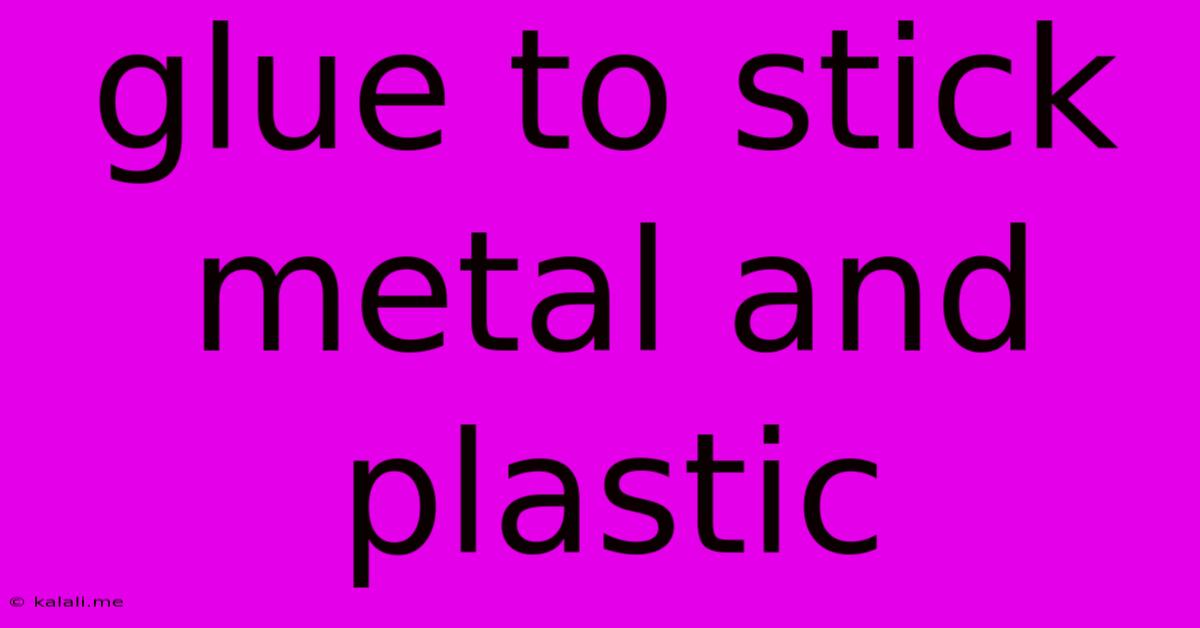Glue To Stick Metal And Plastic
Kalali
May 21, 2025 · 4 min read

Table of Contents
The Ultimate Guide to Gluing Metal and Plastic: Choosing the Right Adhesive
Choosing the right glue to bond metal and plastic can feel like navigating a minefield. Different metals and plastics react differently to various adhesives, and a poorly chosen glue can lead to a weak, unreliable bond that fails quickly. This comprehensive guide will walk you through the different types of adhesives available, their strengths and weaknesses, and help you select the perfect glue for your specific metal and plastic combination. We'll also discuss surface preparation, application techniques, and curing times for optimal results.
Understanding the Challenges of Bonding Metal and Plastic
Metal and plastic are fundamentally different materials. Metals are typically strong, rigid, and non-porous, while plastics can vary significantly in density, flexibility, and porosity. This difference in surface properties makes achieving a strong, lasting bond challenging. Many adhesives require a porous surface for proper adhesion, which is not the case with most metals. Furthermore, the chemical composition of both the metal and plastic will affect the suitability of different adhesives.
Types of Adhesives for Metal and Plastic
Several adhesive types can be used for bonding metal and plastic, each with its own advantages and disadvantages:
1. Epoxy Adhesives: The Workhorse of Bonding
Epoxy adhesives are known for their strong, versatile bond and excellent adhesion to a wide range of materials, including metals and many plastics. They are two-part adhesives (resin and hardener) that need to be mixed before application.
- Pros: High strength, good chemical resistance, gap-filling capabilities.
- Cons: Longer curing times, can be messy to apply, may require clamping during curing.
- Best for: Strong, permanent bonds where high strength and durability are critical.
2. Cyanoacrylate (Super Glue): Fast and Convenient
Cyanoacrylate adhesives, commonly known as super glue, offer incredibly fast bonding times. They are easy to apply and require minimal clamping. However, they are not suitable for all metal-plastic combinations and may not provide the same strength as epoxy.
- Pros: Fast curing, easy application, good for small gaps.
- Cons: Low strength compared to epoxy, brittle bond, sensitive to moisture.
- Best for: Small repairs, quick fixes where high strength isn't essential.
3. Urethane Adhesives: Flexible and Durable
Urethane adhesives are a good option when flexibility is required in the bond. They offer good strength and adhesion to various substrates, including metals and some plastics.
- Pros: Flexible, durable, good impact resistance.
- Cons: Can have longer curing times than cyanoacrylate.
- Best for: Applications where the bond needs to withstand vibration or flexing.
4. Acrylic Adhesives: Versatile and Widely Available
Acrylic adhesives offer a balance between strength, flexibility, and ease of use. They are available in various formulations, including those specifically designed for metal and plastic bonding.
- Pros: Versatile, relatively easy to use, good strength for many applications.
- Cons: May not be suitable for all metal and plastic combinations, strength may be lower than epoxy.
- Best for: A wide range of applications where a good balance of strength and ease of use is needed.
Surface Preparation: The Key to a Successful Bond
Regardless of the adhesive chosen, proper surface preparation is crucial for a strong bond. This involves:
- Cleaning: Thoroughly clean both the metal and plastic surfaces with a suitable solvent to remove dirt, grease, oil, or any other contaminants.
- Roughening (Optional): For some plastics, lightly roughening the surface with sandpaper can improve adhesion. This is less necessary with metals, unless they are highly polished.
- Priming (Sometimes Necessary): For certain metal-plastic combinations, a primer may be needed to improve adhesion. Check the adhesive manufacturer's instructions for recommendations.
Application and Curing
Always follow the adhesive manufacturer's instructions for application and curing. This typically involves:
- Applying the adhesive: Apply a thin, even layer of adhesive to both surfaces.
- Clamping (if necessary): For stronger bonds, especially with epoxy, use clamps to maintain pressure during curing.
- Curing: Allow the adhesive to cure completely according to the manufacturer's instructions. This can range from minutes to hours or even days.
Choosing the Right Adhesive: A Summary
The best glue for bonding metal and plastic depends on several factors, including:
- The specific types of metal and plastic: Some adhesives work better with certain materials than others.
- The required strength of the bond: Epoxy offers the highest strength, while cyanoacrylate offers the fastest bonding time but lower strength.
- The level of flexibility needed: Urethane adhesives are ideal when flexibility is required.
- Environmental conditions: Some adhesives are more resistant to certain chemicals or temperatures than others.
By carefully considering these factors and following the instructions provided, you can achieve a strong, durable, and long-lasting bond between metal and plastic. Remember to always test your adhesive on a small, inconspicuous area first before applying it to the final project.
Latest Posts
Latest Posts
-
What Size Waste Pipe For Sink
May 21, 2025
-
How To Clean A Whiskey Flask
May 21, 2025
-
We Have Fleas But No Pets
May 21, 2025
-
What Is Bigger Than The Universe
May 21, 2025
-
How Do I Do Missions In Gta 5
May 21, 2025
Related Post
Thank you for visiting our website which covers about Glue To Stick Metal And Plastic . We hope the information provided has been useful to you. Feel free to contact us if you have any questions or need further assistance. See you next time and don't miss to bookmark.